Survivors share memories of resilience, rebuilding after 2013 Washington tornado
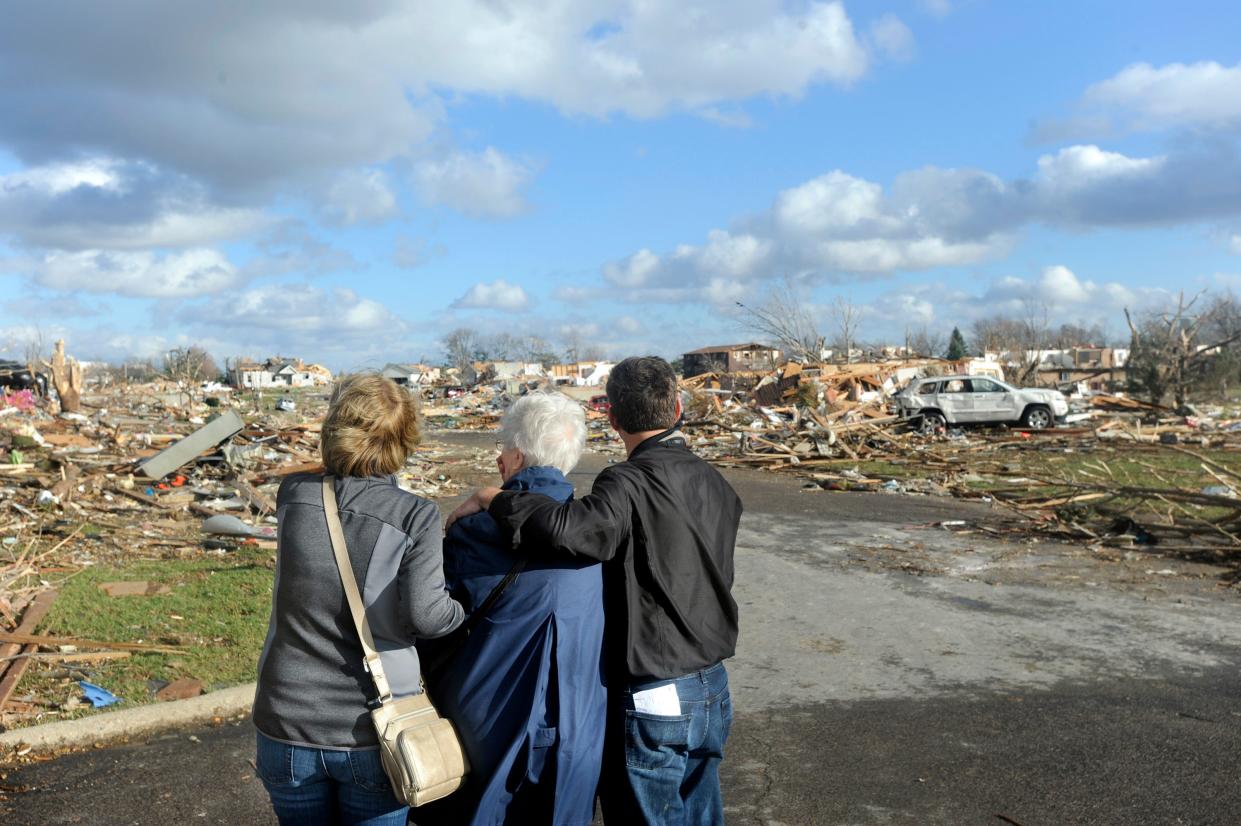
TAZEWELL COUNTY – New construction may have erased the physical damage wrought by a line of tornadoes that ripped through Tazewell County 10 years ago, but the storm left an indelible mark on residents caught in its path.
With warnings from the National Weather Service posted days in advance, the severe storm was not unexpected on the morning of Nov. 17, 2013 — a fact that probably saved many lives.
The two central Illinois tornadoes were part of an outbreak that produced a total of 75 tornadoes across seven states, according to the National Weather Service. In Illinois, eight people died and property damage totaled about $1.05 billion — more than $800 million in Washington alone.
The first tornado, an EF-2 with wind speeds topping out at 120 miles per hour, touched down 1.25 miles northwest of Pekin in Peoria County at 10:52 a.m. and crossed the Illinois River one minute later. It was on the ground for two and a half miles. Ten people were injured and 179 houses and six businesses suffered major damage. An additional 182 houses experienced minor roof damage, three apartment buildings lost their roofs, a power substation had minor damage, and hundreds of cars were damaged, according to the National Weather Service.
More: 'It made us better': How football helped Washington heal from devastating 2013 tornado
The second tornado touched down 2.4 miles southeast of East Peoria at 10:59 a.m. and reached the intensity of an EF-4 with wind speeds topping out at 190 miles per hour as it entered Washington. Three people were killed and 125 were injured – 121 in or near Washington and four in Woodford County.
The tornado cut a half-mile wide swath and was on the ground for more than 46 miles through Tazewell, Woodford, LaSalle, and Livingston counties before dissipating 48 minutes later. More than 1,000 homes were damaged or destroyed by the Washington tornado, which is the strongest November tornado on record in the state. Debris from Washington was found as far away as Chicago.
Lasting effects from the Washington tornado
Tom Claude's home was in the epicenter of the Washington tornado. He is still dealing with symptoms of post-traumatic stress disorder 10 years after the event.
"Every first Tuesday of the month at 10 o'clock when the sirens go off for testing, I cringe when it first comes on,” said Claude. “If I’m holding something, I hold on real tight for just a few seconds, then I relax when I realize it’s just a test.”
Claude heard the warning sirens while watching the storm descend on his home. He roused his wife, Nancy, from bed just seconds before the EF-4 tornado destroyed the duplex where they had lived for nine years. The tornado was gone in less than a minute, but left the pair trapped in their basement until neighbors helped them escape through a window.
The Claudes were uninjured, but if they hadn’t made it to the basement, the result would likely have been different. The house was gone, replaced by a pile of rubble and someone else’s Volkswagen.
"I've got a picture of the bed Nancy was on — it didn’t get blown away. It was close to the center part of the duplex, and that whole center part crashed down and landed on an armoire that came down on the bed. It would have crushed her — if she didn’t get blown out of the house," said Claude.
More: Washington tornado, one year later: City stands strong
The storm was a life-changing event for the Claudes. The pair were out of their home for more than a year, moving into the rebuilt home on Christmas Eve of 2014. Though the home was reconstructed on the old foundation, the pair changed the interior layout.
“It was a three-bedroom duplex. We moved there to downsize after our daughters got married, and we didn’t need three bedrooms," said Claude. “We went to two bedrooms and made the kitchen much larger. Put a lot of cabinets in there and made my wife real happy."
Claude said he plans to mark the 10th anniversary of the tornado in the same way he has marked each anniversary of the devastating event.
"First, I’m going to have a drink and do a little bit of silent celebrating that we are still there and doing well, and it’s in our past," he said. “Every November 17th I think about it most of the whole day. I think about what I was doing at that time when it happened. It’s still very fresh in my mind. It’s been a huge part of my life. Everybody who meets me, they hear I was in the tornado and they want to know all about it. I have pictures on my phone. It always ends up being a couple-hour conversation.”
Talking about the tornado has proven to be good therapy, said Claude.
“I heard some people who thought they had PTSD, and had gone to get some therapy. They were told to tell the story, because the more you tell it, the more it becomes a story, as opposed to a horrible event in your life.”
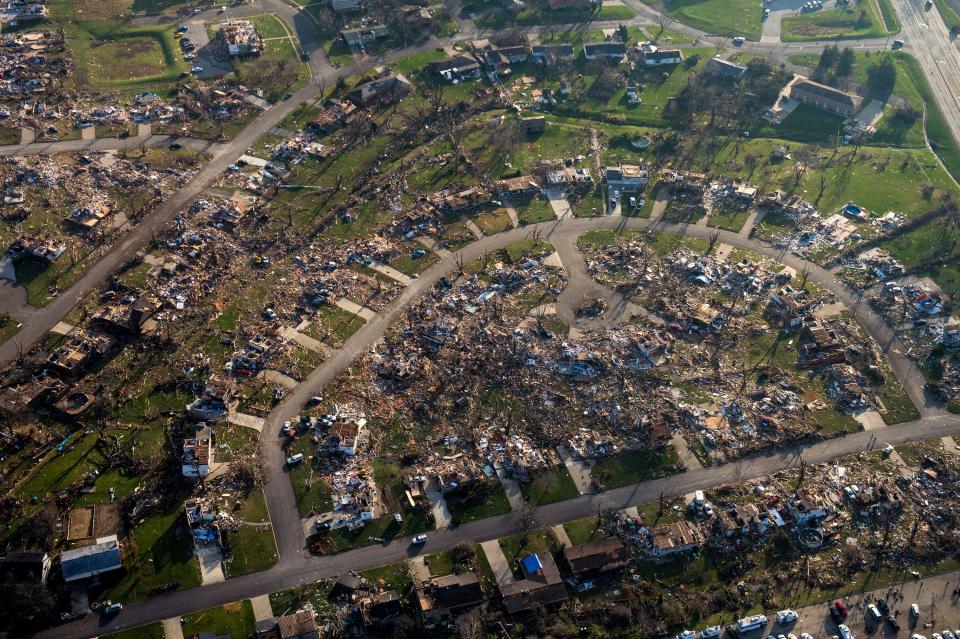
'This time of year is hard'
Though Jennifer Deeb’s Washington home was not in the path of the tornado, she still tears up when recalling events of that day. A nurse trained as a first responder, Deeb rushed to the Washington Fire Station to volunteer after learning that a section of town had been hit by a tornado.
Deeb helped set up a temporary medical facility at Five Points Washington, where people went for a variety of resources after the storm. Over the course of the day, medical personnel treated about 150 people for a variety of injuries, from bruises to cuts requiring stitches, said Deeb.
During that busy day, Deeb learned more about how bad the devastation was, but she was still shocked when someone from a mortuary showed up at Five Points.
“He said, ‘They called for body bags. I have them in my car.’ And I thought, ‘Oh, God.’ Then we had to discuss where you would set up a morgue. I still get emotional about it,” said Deeb.
More: For seasoned weatherman Chuck Collins, the Washington tornado marked many milestones
November is a difficult time for people affected by the tornado, said Deeb.
“I think everyone will tell you this time of year is hard, when the weather is similar," said Deeb. “We move past it – obviously we can talk about it now. When you are medical, you have to push all of your emotions back to be able to function. But of course, they come back up at certain times.”
Life after the storm
A retired horticulture professor, Randey Wall always admired the trees while walking through his Washington neighborhood. Little did he know during his walk on the unusually warm morning of Nov. 17, 2013, that he was seeing most of them for the last time.
"These were some large, older, mature trees. Now there’s only a few that are left,” said Wall.
Later that morning, tornado sirens and a swirling cloud of debris prompted Wall to head to his basement. The sound of debris hitting the house was "like someone hitting the siding with a sledgehammer.” When Wall crept back upstairs, the view outside his living room window revealed extensive damage all around.
Wall immediately went outside to help his neighbors. Because his vehicle was in the garage and still drivable, Wall ferried several people to OSF Saint Francis Medical Center. They were among the first to arrive at the hospital after the tornado, Wall said.
Though his house sustained significant damage, Wall was able to live there after the storm. It was exceedingly difficult, however, and not just because of the lack of water, gas, and electricity. Law enforcement restricted access into the damaged area and several times, after returning home with supplies like water and gasoline for the generator, Wall was turned away. Sometimes he parked his car several miles away in Sunnyland and walked home; sometimes, after trying multiple checkpoints, he found someone who would let him drive in.
“I never did understand that,” said Wall. “They brought in a number of different people from out of town – there were officers from Springfield and Decatur and places up north - and the people from out of town were generally more willing to let me pass when I showed them my driver’s license and where I lived, whereas the Washington police just did not care. They told me to park and walk. But I said, ‘I’m living there, I'm trying to survive.’ It wasn’t like there were very many of us ... maybe five houses in the entire area where maybe people were still there.”
More: Washington family bloodied and battered, but alive, after Sunday tornado
Realizing it was a difficult time for everyone, Wall doesn’t hold any ill will toward police, but he thinks the stress of the situation contributed to the heart condition he is still dealing with today. Ten days after the tornado, Wall thought he was coming down with a cold and went to the Morton Prompt Care, where he learned that he was having a heart attack. At the hospital, he was told that the stress of the situation was definitely a contributing factor.
"The stress, and the exhaustion, trying to manage the household, and trying to help neighbors pick up all their debris. Helping the neighbors out all that week, that was hard,” said Wall.
Ten years after the tornado, Wall still lives in the home, which cost about $30,000 to repair. Now 73 years old, he is vigilant about his weakened heart.
“I still have to deal with the issues of the heart attack, that was pretty significant,” he said. “I’m OK, but anything that happens, I have to see my cardiologist. So that’s lingering.”
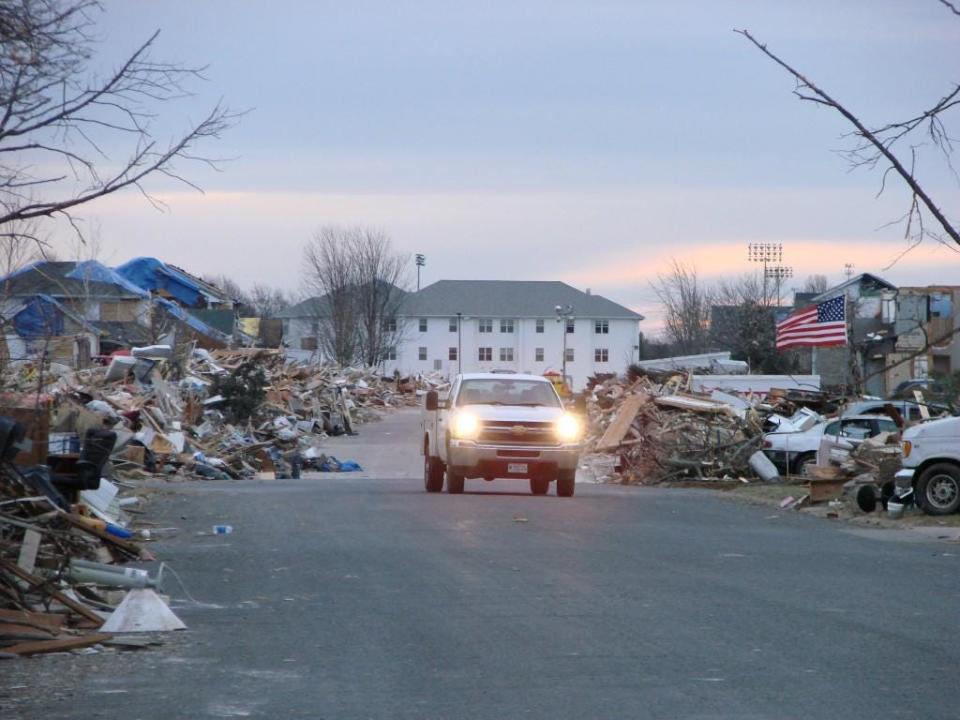
'I thought we were going to die'
Video of 5-year-old Kylie Lutschg being pulled her from the rubble of her Washington home ended up on the Weather Channel, but to this day, her mother, Jessica Lutschg Ortiz, has no idea who shot it.
Mother and daughter made it to the basement seconds after Ortiz glanced out the front door to see a tornado spinning next door. Ortiz flung a plastic tote over her daughter’s small body and hunched over the tote.
“I was crying. I thought we were going to die. I honestly thought it was over," said Ortiz. “It was so loud, and then there were bricks flying through the walls and they were hitting everywhere, and the pipes were bursting and there was water everywhere. It was horrible.”
When the storm passed, Ortiz discovered that they were trapped.
“When Kylie got up, I didn’t want her to come from under the steps 'cause all the pipes were leaking and there was water spraying everywhere,” said Ortiz.
It took about 30 minutes for rescuers to clear debris from over the stairs. Kylie was the first one out of the basement because she could fit through a smaller hole. When Ortiz was finally able to walk up the stairs, she was overwhelmed by what she saw.
“I was in total shock because nothing was left. My vehicle, which was in the garage, landed in my kitchen. We were lucky it didn’t land over the stairs because we would have been trapped a lot longer,” she said.
Ortiz looked for her cat, Oliver, who didn’t turn up until 13 days later. Volunteers found him while sifting through the debris. He was rolled up in the bedroom rug.
“He must have been surviving off drips of water or something,” said Ortiz. “Oliver was just a real special cat. He didn’t have any broken bones or anything, he was just really thin. We were staying in Stoney Creek Inn and they let me have him in the room, and we got him back to health.”
More: Tornado victims share their stories of survival and rebuilding
While details of the tornado are clear in Ortiz’s memory, the many months following are a blur. Ortiz remembers lots of people helping her, and living in multiple places until their home, one side of a duplex, was rebuilt.
“I was honestly so severely affected by the tornado, I was missing messages. I was just wading through people who were reaching out to me to help, and I just didn’t know how to process it all at once,” said Ortiz.
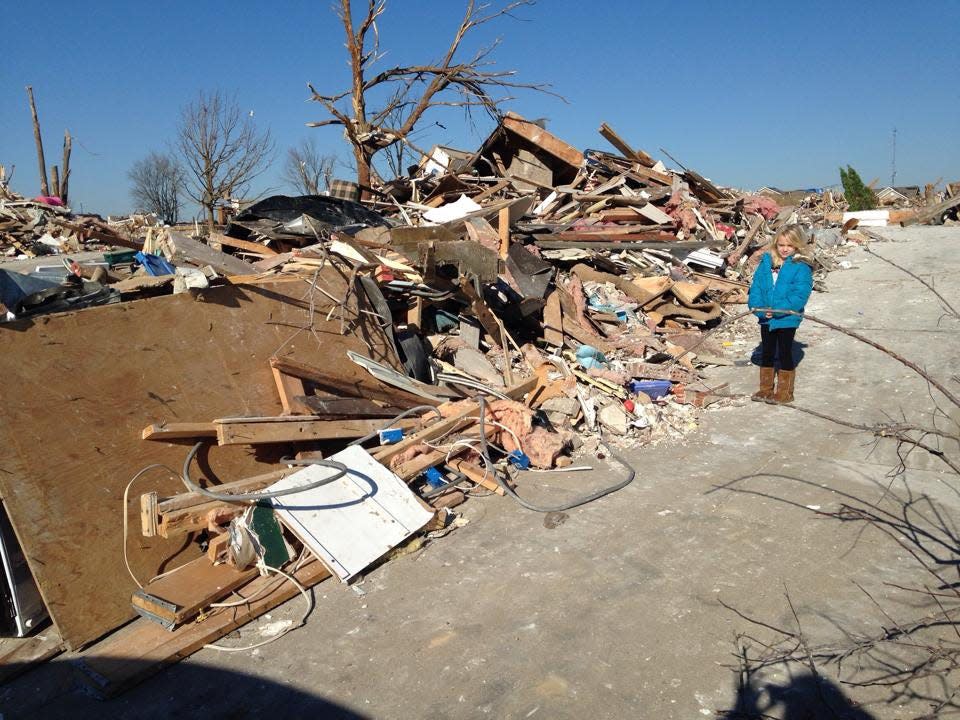
While Ortiz still owns the home, she no longer lives there. She moved to Colorado after she got married.
"Honestly, I don’t think we could have stayed there,” she said. “Anytime there was a tornado alarm it was just really stressful. They don’t have that here — there have been no tornadoes in the area, and I think that has been really good for Kylie and me.”
Rebuilding in Pekin was a challenge
Vicki Ghidina’s North Pekin home was one of the last homes to receive a settlement from an insurance company. It took seven months for adjusters to decide how to handle the claim, and a full year and a half for the home to be rebuilt.
“It was a 10 or 12 adjuster project because we weren’t flattened – it would have been much easier if we had been flattened,” said Ghidina. "The roof was gone on part of it, the garage was caved in, windows broken – that was pretty much it to look at it, but when the adjusters came out, I mean, the wiring had been pulled when the wind took the roof.”
Ultimately, the Ghidinas built a whole new house, footing the bill for a new foundation themselves because they were concerned about mold after the structure stood open to the elements for so long.
More: Two fates for two houses hit by 2013 tornado on same Pekin block
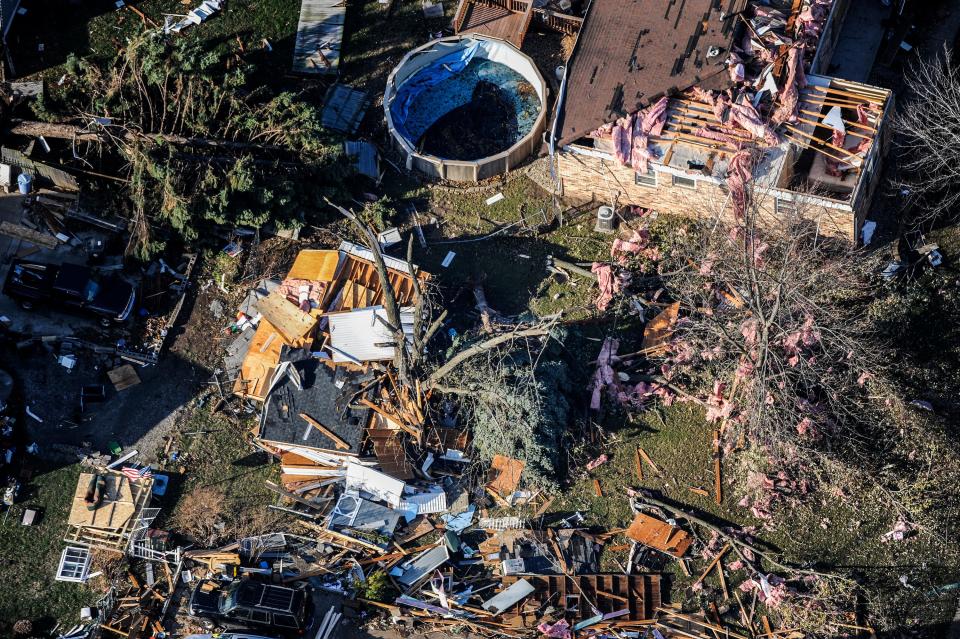
Ghidina was at church in Peoria when the tornado hit Pekin, but her husband and one of her sons were at home. The pair sheltered in the basement until the storm passed. By the time Ghidina got back to Pekin, family and friends were already helping the family remove valuables from the home.
The family lived in a rental until their home was rebuilt. The new house is very much like the old one, with essentially the same layout, but reminders of the tornado were incorporated into the new structure. They include a concrete-reinforced safe room beneath the front porch, a bar in the basement built from bricks salvaged from the old home, and an engraved brick commemorating the event mortared into the front of the home.
“Peoria Brick Company made a brick for any family who was affected by the storm,” said Ghidina. “The brick was 'Washington Strong,' and it had the date on it. But there were other people outside of Washington who were affected by it, so we have a 'Central Illinois Strong' brick on the side of our house.”
'You can rebuild it'
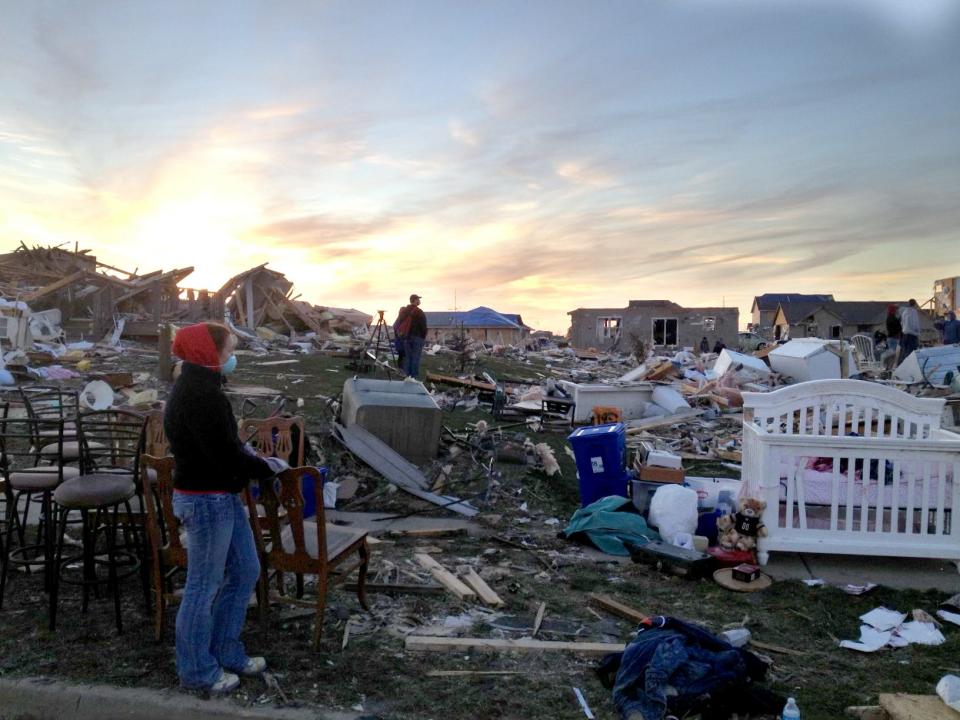
Misty Dykema is thankful that no one, not even the dog, was home when the EF-4 tornado destroyed her Washington home.
“We had actually taken our dog in the car with us to church that day,” said Dykema. “He loved riding in cars, so at least he was with us.”
The family heard about the tornado while they were at breakfast. While driving back into town, they began seeing damage about a half mile from their home.
“Then we got to the point where we couldn’t drive any farther and it was just complete devastation — cars toppled on top of each other, you could still see people climbing out of their basements. It was a Sunday morning, so kids didn’t have shoes on, people were in their pajamas, and you could smell gas. It was like a war zone,” said Dykema.
More: Following the dollars: Where did Washington's tornado relief money go?
As her husband ran to help a 90-year-old neighbor, Dykema was deluged with people asking her to drive their kids and pets out of the danger zone. Afterward, Dykema parked the car and walked through the debris to see what had become of the family’s home.
“I was all bloody, my jeans were ripped up by the time I actually got back to where my house would have stood,” she said. “Every single thing that we owned was gone. The only thing left standing was my daughter’s crib.”
In the days following the tornado, as the family sorted through the rubble, Dykema was powered by adrenaline.
“I tear up still thinking about it because I remember my mom saying to me, ‘Misty, you're not letting yourself think about it and you're just moving through it,’” said Dykema. “I remember feeling like I didn't really lose anything because I still had my family, and I'm not really worried about things because you can rebuy things. But my mom was laughing at me because I was picking up forks that were bent or one shoe that they didn't have another match, and it wasn't because I cared about the stuff, it was because I cared about the life that I had built in that home, and the memories. I think that’s how everybody felt.”
Like many tornado survivors, Dykema was buoyed by the support of others.
“My coworkers at Simantel opened a GoFundMe page for myself and another employee — we lived about three or four houses apart and we both lost everything. Both GoFundMe pages raised over $10,000,” said Dykema. “Probably my most inspirational time was seeing my coworkers drive up to my house — my grandmother’s house, where I was staying — with just tons of totes and boxes and garbage bags. They didn’t know how to support me, but they wanted to get me the materials to save whatever was left of my life.”
Dykema learned important lessons from the tragedy, one being about her strength and ability to push through difficulty. The other lesson was about what’s truly important.
“As long as you're safe and you have your people, you can pretty much do anything,” she said. “If you have your people around you, the rest is just stuff. You can rebuild it.”
More: Washington mourns for, remembers tornado victims
Leslie Renken can be reached at (309) 370-5087 or lrenken@pjstar.com. Follow her on Facebook.com/leslie.renken.
This article originally appeared on Journal Star: Survivors mark 10 years since November 2013 Washington tornado

